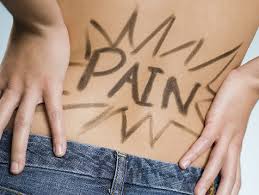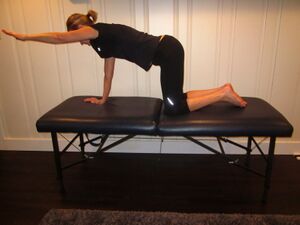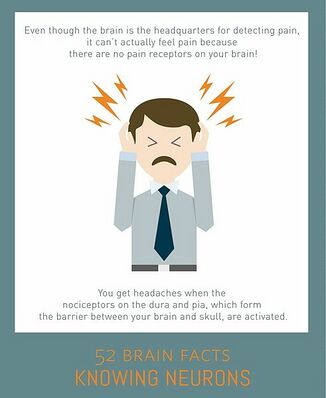Chronic Low Back Pain
Original Editors - Bryan Jacobson, Tori Westcott, Ashley Bohanan, Alisha Lopez
Top Contributors - Bryan Jacobson, Meg Howitt, Cindy John-Chu, Nele Kiekens, Kim Jackson, Lucinda hampton, Laura Ritchie, Admin, Chloe Johnson, Tori Westcott, Jonathan Wong, Joshua Samuel, Judith Vrydag, Rachael Lowe, Jeremy Brady, George Prudden, Evi Van Cauwelaert, Simisola Ajeyalemi, Eric Robertson, Ashley Bohanan, Aminat Abolade, Evan Thomas and Scott Buxton
Introduction[edit | edit source]
Chronic low back pain (CLBP) is defined as lower back pain lasting for longer than 12 weeks or 3 months, even after an initial injury or underlying cause of acute low back pain has been treated.
Key Points
- CLBP develops in roughly 5.0% to 10.0% of low back pain cases.[1][2]
- CLBP represents the second leading cause of disability worldwide and is a major health and economic problem.
- CLBP has a significant impact on functional capacity and occupational activities, and can also be influenced by psychological factors, such as stress, depression and/or anxiety.[3]
- Patients often have unrealistic expectations of total pain relief, being a large gap between a patient's desired amount of pain reduction and the minimum percentage of improvement that makes a treatment worthwhile. [4]
Epidemiology /Aetiology[edit | edit source]
- The prevalence of CLBP in adults has increased more than 100% in the last decade and continues to increase dramatically in the ageing population, affecting both men and women in all ethnic groups.[3]
- CLBP prevalence varies according to age, prevalence was 4.2% for individuals aged between 24 and 39, and 19.6% for people aged between 20 and 59[5].
- Higher prevalence in females, people of lower economic status, those with less schooling, and smokers compared to males, people with higher economic status, those with more schooling, and non-smokers, respectively.[6]
Characteristics/Clinical Presentation[edit | edit source]
CLBP refers to LBP occurring for longer than three months, and possibly occurring episodically. Social contact and work environment will suffer from the impact on the patient's health and wellbeing.
Presentation includes:
- Pain in the lower area of the back, which may radiate into the lower extremities.
- Movement and coordination impairments
- Difficulty maintaining the neutral position and/or to maintain a standing, sitting or a lying position, especially in case of radiating pain to the lower extremities.
- Carrying objects in the arms, or bending can also provoke complaints.
- Daily activities such as household tasks, sports and other recreational activities can be challenging for people with CLBP.
- When pain is generalized, sensory experiences of the patient can also become altered
- Fear-avoidance beliefs, pain catastrophizing (see Pain Catastrophizing ) and depressive thoughts can appear (monitor these Yellow Flags, blue flags and black flags).[7]
Red Flags: Although uncommon, serious spinal conditions (such as those listed below) may present as chronic LBP in approximately 5% of patients presenting to primary care office:
- Cauda equina syndrome
- Cancer
- Ankylosing spondylitis
- Lumbar Spinal Stenosis
- Lumbar disc herniations
- Lumbar Spine Fracture
- Spondylodiscitis
- Abdominal Aortic Aneurysm[8]
Diagnosis[edit | edit source]
In most cases, causes for CLBP are not found using traditional investigations.
- Fewer than 10% of cases are diagnosed with radiography and magnetic resonance imaging (MRI).
- Degenerative changes and conditions such as spondylolysis and spondylolisthesis are not reliable diagnoses for CLBP, as they are no more common in patients with pain than in asymptomatic individuals.[9]
Generally, patients are diagnosed based on their history. The specific diagnosis is then formulated based on the examination and clinical outcomes.
Examination[edit | edit source]
- Research has shown that patient history and biopsychosocial evaluation are crucial to establish CLBP[10].
- The focus of the physical examination is to confirm the hypothesis of CLBP by eliminating other pathologies or mechanisms, such as the aforementioned red flags.[11]
- There are also clinical tests that could be used to sort patients with a higher risk for CLBP from patients with subacute LBP. The best predictor is the lumbar spine flexion test. Other differences might be seen in functional tests, sensation in the feet, and in the different pain provocation tests.[12]
Outcome Measures[edit | edit source]
Can be used at baseline and throughout the course of treatment to monitor a change in a patient’s status.[7]
- STarT Back
- Oswestry Disability Index
- Roland‐Morris Disability Questionnaire
- Patient-specific functional scale (PSFS)
- The loaded forward-reach test
- Pain self-efficacy questionnaire (PSEQ)
Medical Management[edit | edit source]
All the guidelines currently available stress the importance of a multimodal and multidisciplinary approach in order to determine a strategy to solve CLBP, not simply alleviate symptomatic pain.[3] See Multidisciplinary Care in Pain Management
Treatment for chronic low back pain is grouped into into three wide categories: monotherapies, multiidisciplinary therapy, and reductionism.
- Monotherapies: do not work or have limited effectiveness (eg, analgesics, non-steroidal anti-inflammatory drugs, muscle relaxants, antidepressants, physiotherapy, manipulative therapy and surgery).
- Multidisciplinary therapy based on intensive exercises improves physical function and has modest effects on CLPB.
- The reductionist approach, meaning the pursuit of a pathoanatomical diagnosis with the view to target-specific treatment, should be implemented when a specific diagnosis is essential. Searching a pathoanatomical diagnosis has been criticised on the grounds that it ignores the psychosocial aspects of chronic pain. However advocates of reductionism have persisted, as monotherapies and multidisciplinary therapy to date, have not provided a good solution to chronic low back pain.
Imaging: Conventional investigations often do not reveal the cause of pain however joint blocks and discography can identify zygapophysial joint pain (in 15%–40%), sacroiliac joint pain (in about 20%) and internal disc disruption (in over 40%). Zygapophysial joint pain can be relieved by radiofrequency neurotomy; techniques are emerging for treating sacroiliac joint pain and internal disc disruption.[9]
Multidisciplinary Approach
In patients who have already failed a course of conservative treatment, multidisciplinary rehabilitation programmes result in better outcomes with respect to long term pain and disability compared with usual care or physical treatments. Patients in these programmes also have increased odds of being at work compared with patients receiving physical treatment.[13] For more information see - Behavioral pain management of chronic low back pain
Physical Therapy Management[edit | edit source]
Patients with CLBP should receive information about effective self-care options and should be advised to remain active (because muscles that do not move can eventually become hypersensitive to pain). Assessing the response to therapy is focused on improvements in pain, mood, and function.[4] A multidisciplinary approach in treating chronic low back pain is advised. See also Communication in Chronic Pain Conditions
Therapy consists of:
- Stretching and flexibility exercises: are used to improve hamstring, quadriceps, piriformis, and hip joint capsule range of motion.[14] The aim is to reduce pain, improve movement, and improve functional limitations of movement.
- Strengthening and stabilizing the back and abdominal core muscles: produces small improvements in pain and functioning in patients with chronic low back pain. Few however studies (i.e., six of the 43 studies included in a Cochrane review) demonstrated clinically important and statistically significant differences between intervention and control groups.[4]See Core Strengthening and The Effectiveness of Core Stability Exercise in the Management of Chronic Non-Specific Low Back Pain
- Massage is now recommended in both the acute and chronic stages of back pain but modalities such as electrical nerve stimulation, low-level laser therapy, shortwave diathermy and ultrasonography have not been shown to be effective interventions. Exercise focusing on general improvement of strength and cardiovascular endurance is not suggested for optimal outcomes in patients with chronic low back pain.
- Cognitive Behavioural Therapy: For patients with nonspecific chronic low back pain, more specifically patients who have already had full conservative treatment, a biopsychosocial rehabilitation program might result in positive long term effects on pain and disability. For more information see: CBT Approach to Chronic Low Back Pain
- Pain Neuroscience Education (PNE): Pain neuroscience education (PNE) is a strategy that teaches patients to rethink the way they view pain. Pain neuroscience education utilises various stories and metaphors to help patients reconceptualise their pain experience. PNE aims to increase pain thresholds during exercise, decrease fear related to movement and decreased brain activity in brain regions associated with pain.
Other Options Include:
- Manipulative therapy: found in the latest meta-analysis to be slightly more effective than sham therapy however no more effective than other forms of care, for example care by a general practitioner, physiotherapy or exercises,[9]
- McKenzie Method: Has been shown to be as effective as other exercise therapy. Compared to motor control exercises there is no significant difference in pain and function scores. However patients reported greater improvement in sense of recovery in the short term compared to patients who received motor control exercises. This obviously might differ across different groups of patients.[15]
- Acupunture is no longer supported by the UK and Belgian guidelines but is still supported by the American guidelines state that acupuncture massage and pressure point massage are minimally helpful for reducing CLBP, with benefits lasting for up to one year.[16]
- Pilates:There is inconsistent evidence that pilates is effective in reducing pain and disability in people with CLBP, with a lack of long term follow up information.[17] The use of Pilates was found to improve ongoing Low Back Pain (LBP) in patients who received conventional physiotherapy treatment, the improvement was most obvious in the female population group.[18]
- Yoga: Evidence in recent years has suggested yoga to be an efficacious adjunctive treatment for chronic low back pain [19]. Yoga has had a positive impact on pain and function outcomes in patients with CLBP. It has been found to have a statistically significant difference compared to minimal intervention. However, results comparing to exercise and usual physiotherapy are inconsistent. Yoga should be considered as an adjunct to usual physiotherapy until further higher quality studies have been produced.
Resources[edit | edit source]
https://www.youtube.com/watch?v=DBh4_7YtLaA
Clinical Bottom Line[edit | edit source]
A multidisciplinary approach in treating chronic low back pain is advised. Especially in patients who have already failed a course of conservative treatment, multidisciplinary rehabilitation programs result in better outcomes with respect to long term pain and disability compared with usual care or physical treatments. Physical therapy should consist of exercise therapy (and no manual therapy). The exercise therapy might be general exercise therapy, the Mckenzie method, or motor control exercises. Pilates and yoga could be used if the patient has interest in this. Biopsychosocial rehabilitation is advised in patients with nonspecific chronic low back pain, education and graded exercise could also play an important role for these patients. Above all, it’s important to choose a therapy that fits the individual patient.
References[edit | edit source]
- ↑ Meucci RD, Fassa AG, Faria NM. Prevalence of chronic low back pain: systematic review. Revista de saude publica. 2015 Oct 20;49:73.
- ↑ NIH Low Back Pain Fact Sheet Available: https://www.ninds.nih.gov/low-back-pain-fact-sheet(accessed 17.11.2022)
- ↑ 3.0 3.1 3.2 Allegri M, Montella S, Salici F, Valente A, Marchesini M, Compagnone C, Baciarello M, Manferdini ME, Fanelli G. Mechanisms of low back pain: a guide for diagnosis and therapy. F1000Research. 2016;5. Available:https://www.ncbi.nlm.nih.gov/pmc/articles/PMC4926733/ (accessed 17.11.2022)
- ↑ 4.0 4.1 4.2 AFP Chronic Low Back Pain: Evaluation and Management Available;https://www.aafp.org/pubs/afp/issues/2009/0615/p1067.html (accessed 18.11.2022)
- ↑ Meucci RD, Fassa AG, Faria NM. Prevalence of chronic low back pain: systematic review. Rev Saude Publica. 2015;49:1. doi: 10.1590/S0034-8910.2015049005874. Epub 2015 Oct 20. PMID: 26487293; PMCID: PMC4603263.
- ↑ Meucci RD, Fassa AG, Faria NM. Prevalence of chronic low back pain: systematic review. Revista de saude publica. 2015 Oct 20;49:73.Available:https://www.ncbi.nlm.nih.gov/pmc/articles/PMC4603263/ (accessed 17.11.2022)
- ↑ 7.0 7.1 Delitto A, George SZ, Van Dillen L, Whitman JM, Sowa G, Shekelle P, et al. Low Back Pain: Clinical Practice Guidelines Linked to the International Classification of Functioning, Disability, and Health from the Orthopaedic Section of the American Physical Therapy Association. J Orthop Sports Phys Ther. 2012;42(4):A1-A57.
- ↑ Lumbar Assessment
- ↑ 9.0 9.1 9.2 MJA Management of CLBP Available:https://www.mja.com.au/journal/2004/180/2/management-chronic-low-back-pain (accessed 17.11.2022)
- ↑ McCarthy CJ, Arnall FA, Strimpakos N, Freemont A, Oldham JA. The biopsychosocial classification of non-specific low back pain: a systematic review. Physical Therapy Reviews. 2004 Mar 1;9(1):17-30.
- ↑ Chou R, Qaseem A, Snow V, Casey D, Cross Jr JT, Shekelle P, Owens DK. Diagnosis and treatment of low back pain: a joint clinical practice guideline from the American College of Physicians and the American Pain Society. Annals of internal medicine. 2007 Oct 2;147(7):478-91.
- ↑ Paatelma M, Karvonen E, Heiskanen J. Clinical perspective: how do clinical test results differentiate chronic and subacute low back pain patients from" non-patients"?. Journal of Manual & Manipulative Therapy. 2009 Jan 1;17(1):11-9.
- ↑ Kamper SJ, Apeldoorn AT, Chiarotto A, Smeets RJ, Ostelo RW, Guzman J, Van Tulder MW. Multidisciplinary biopsychosocial rehabilitation for chronic low back pain: Cochrane systematic review and meta-analysis. Bmj. 2015 Feb 18;350.
- ↑ Maddalozzo GF, Kuo B, Maddalozzo WA, Maddalozzo CD, Galver JW. Comparison of 2 multimodal interventions with and without whole body vibration therapy plus traction on pain and disability in patients with nonspecific chronic low back pain. Journal of chiropractic medicine. 2016 Dec 1;15(4):243-51.
- ↑ Halliday MH, Pappas E, Hancock MJ, Clare HA, Pinto RZ, Robertson G, Ferreira PH. A randomized controlled trial comparing the McKenzie method to motor control exercises in people with chronic low back pain and a directional preference. Journal of Orthopaedic & Sports Physical Therapy. 2016 Jul;46(7):514-22.
- ↑ Qaseem A, Wilt TJ, McLean RM, Forciea MA. Noninvasive treatments for acute, subacute, and chronic low back pain: a clinical practice guideline from the American College of Physicians. Annals of internal medicine. 2017 Apr 4;166(7):514-30.
- ↑ Wells C, Kolt GS, Marshall P, Hill B, Bialocerkowski A. Effectiveness of Pilates exercise in treating people with chronic low back pain: a systematic review of systematic reviews. BMC medical research methodology. 2013 Dec;13(1):1-2.
- ↑ Pilates Pilates
- ↑ Holtzman S, Beggs RT. Yoga for chronic low back pain: a meta-analysis of randomized controlled trials. Pain Research and Management. 2013 Oct;18(5):267-72.









